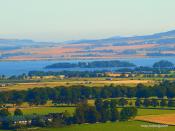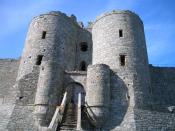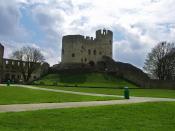In medieval times, castles served as the home and fortress of a monarch or noble. The earliest castles were built from earth and wood. By the 12th century, most castles were built from stone. The stones came from local mines or quarries if possible, but sometimes they had to be carried long distances by water or on ox wagons. The roofs of castles were covered with slates, clay tiles, or wooden shingles.
Castles were built on steep hillsides or at the top of rocky cliffs. This was for protection from attackers. It made it harder for them to reach the castle.
Castles also had additional purposes. They sometimes served as barracks, prisons, storehouses, armories, treasure houses, and the center for local government. Castles sometimes had brew houses, a laundry a huge bakers oven, workshops, dovecotes, and stables. Huge walls surrounded the entire castle and were usually several meters thick. They usually had 3 layers: a rough stone inner shell, a thick, solid filling of flint and rubble, and an outer layer of stone called ashlars.
There was usually a walkway along the top of the walls so guards could keep watch. Some castle walls had spaces at the top called embrasures, which allowed archers to shoot with the protection of the wall. These openings also permitted stones or boiling water to be thrown down on the enemy. Towers were built along castle walls at regular intervals to strengthen them and provide area for castle workers or visitors.
Moats often surrounded castles for protection. Some people built castles on banks of lakes or rivers and channeled water to the moat. A drawbridge laid across the moat and could be raised if an enemy approached. Castles had few windows, because they made the castle drafty and allowed the enemy a way inside.


